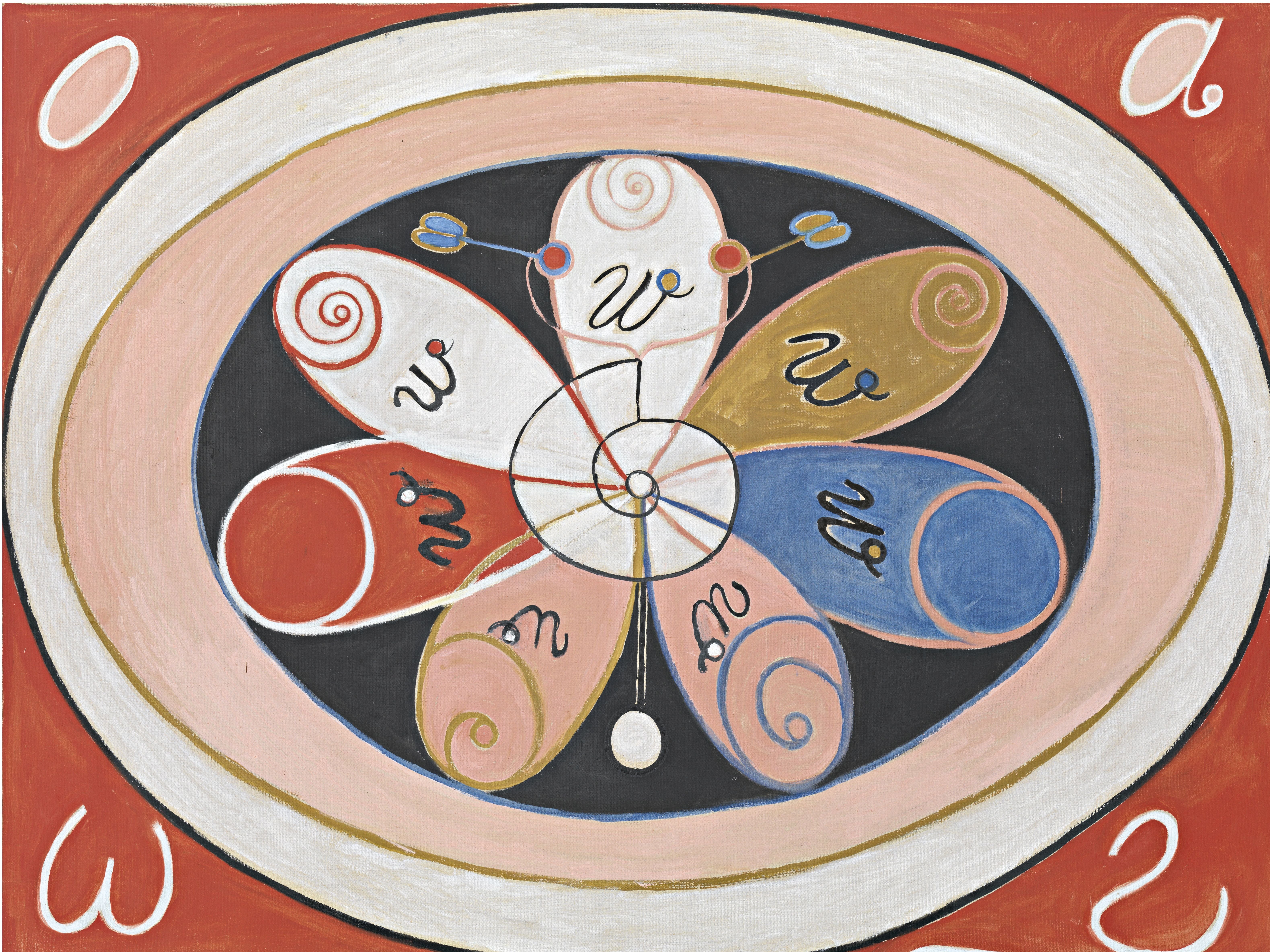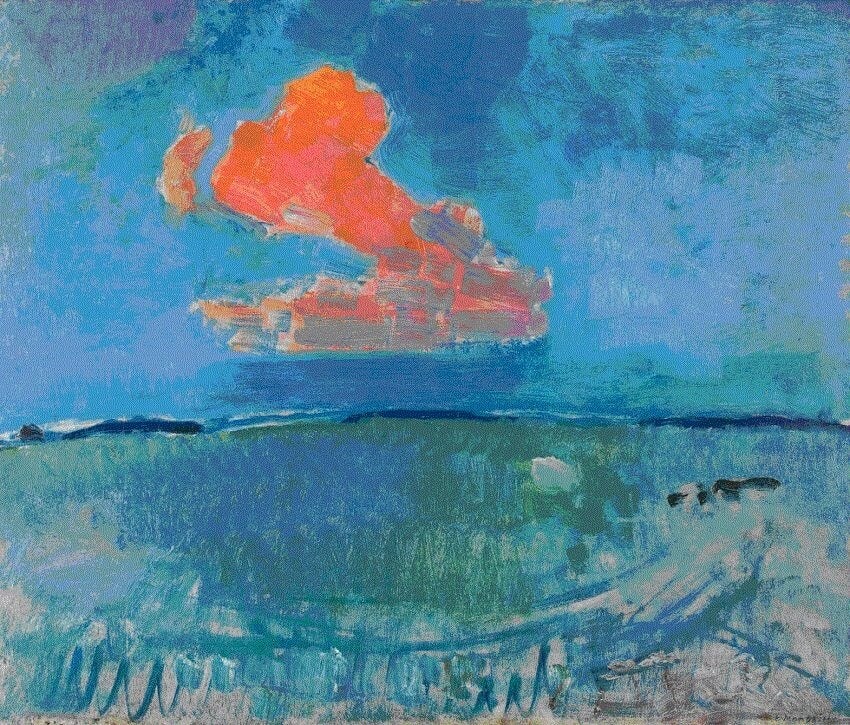Hilma af Klint & Piet Mondrian – Forms of Life review: Two extraordinary artists, crossing briefly in the story of modern art
The Tate’s show is a fascinating pairing, but it feels like Af Klint’s moment in the sun is beginning

When Hilma af Klint had her first substantial British showing at the Serpentine Gallery in 2016, she appeared a fascinating if very niche figure. The early 20th-century Swedish mystical painter had produced completely abstract paintings at around the same time, if not slightly earlier, than Kandinsky, Malevich, Mondrian and the other great dons of Modernism.
The fact that Af Klint was a spiritualist medium whose works had, she believed, been “commissioned” by higher powers, seemed to confine her relevance to a quirky substratum of Modern Art; a kind of rarefied “outsider” artist. The fact that her paintings had remained hidden, at the artist’s request, until 20 years after her death in 1944, was all part of the wacky back story.
Seven tumultuous years after that Serpentine show – a period in which established cultural canons have been challenged at every turn – Af Klint is now definitively established as the First Abstract Artist. Her paintings’ spiritual origins, meanwhile, seem on trend with a new visionary turn in art. This is evident in everything from Marguerite Humeau’s speculative realities, currently showing at White Cube, to Jadé Fadojutimi’s Manga-inspired abstract mindscapes, which command the highest prices of any young British painter of recent times.
So, one could say that Piet Mondrian, one of the great titans of old school Modernism, appears lucky to be sharing a stage with her in this major exhibition at Tate Modern.
This is show that might easily be construed as a showdown between incompatible value systems: between rigid, male-dominated, implicitly atheist functionalism on the one hand, and a more inclusive, spiritually expansive woman-centred view of art’s possibilities on the other. The curators, however, are intent on drawing out the shared origins and concerns of the two artists, as well as the radically divergent art produced by them.
Both artists took their starting point from nature, and emerged in an early 20th-century moment when Western culture was in a state of spiritual ferment. Scientific breakthroughs, such as the discovery of sub-atomic structure and radioactivity, had enhanced rather than diminished a widespread urge to engage with invisible, otherworldly realities.
Af Klint, born in 1862, was 10 years Mondrian’s senior, but their early landscapes in a sombre, understated Nordic Impressionist style are barely distinguishable. Where Mondrian’s early flower studies look to Van Gogh and Japanese art in their exquisitely stylised lines, Af Klint’s early botanical drawings – sadly undated – have a Durer-like scientific exactness.

From these sedate beginnings the exhibition plunges into the occult with Af Klint’s frankly bizarre Evolutions series of paintings from 1908. Cruciform images morph over the 15 canvases into human figures, butterfly forms and inscrutable body parts, with female ovaries clearly evident in one painting.
While Af Klint studied at Stockholm’s Royal Academy of Fine Arts, she became involved around 1896 with a group of other women Christian spiritualists, some of them also artists, who took “dictation” in verbal and visual form from unseen spiritual “masters”. A group of paintings entitled Primordial Chaos, intended, like all Af Klint’s work, as decorations for a notional temple, constitute the basis of those claims for her as the First Abstract Artist.
In the absence of any work from that crucial series, the Evolution paintings transport us to a realm of esoteric ritual which is about as far as can be imagined from the tasteful formal reductions of mainstream Modernism. They’re disconcerting works, weirdly medieval and modern all at once.
But then Mondrian responds from the opposite wall – and the show, of course, inevitably becomes a competition – with his own painting on the subject of Evolution that’s nothing like anything you’ll have seen from the master of abstract right angles and primary colours. His triptych Evolution (1911) shows three ethereal, blue-tinged naked women representing humanity’s progress from the spiritual, gazing heavenward in what could pass for a design for some preposterous art nouveau opera poster.
The painting dates from shortly after Mondrian’s induction into the Theosophical Society, which taught the spiritual connectedness of all religions, in 1909 – Af Klint had joined in 1904. While he retained his preoccupation with the mystical, he soon shifted back from ludicrous fin-de-siecle fantasy to radical abstraction from observed reality. The clearly Van Gogh-inspired The Red Tree (1908-10), with its incandescent red trunk and branches twisting across sumptuous ultramarine, leads to a succession of monochrome tree studies in a sort of flattened-out cubist style. In his glorious breakthrough painting Composition in Oval with Colour Planes II (1914) you can sense the flattened planes of the everyday world transforming themselves into the purely abstract forms of his classic Neo-Plasticist painting that would begin to emerge two or three years later.
If Mondrian seems driven towards the external world as he forges new forms of visual perception, Af Klint looks resolutely inwards in a series of rather prissy pink-tinged occult diagrams dominated by childishly stylised flower forms. Her early supposedly abstract works are indeed so laden with patently figurative imagery – flower and leaf forms, shells, vine-like tendrils – that the whole First Abstract Artist schtick that’s been constructed around her starts to feel not just like conjectural hype, but a red herring. Not only were spiritualist artists and mediums creating “abstract” imagery decades before she came on the scene – as the exhibition itself makes abundantly clear – but abstraction in the Modern Art sense is the very last thing her work is about.

She comes into her own here with the Swan series, painted in 1914, at a point when she claimed to be painting according to her own impulses rather than under the direction of spiritual guides. The image of the swan, representing unity in the occult, is carried through varying degrees of realism and abstraction over 19 canvases – nine of which we’re shown – in images that bring to mind everything from medieval heraldry to pop art. Paintings that, in their severe fields of flat colour recall the hard edge abstraction of the 1960s, have tiny triangles at their centres clearly with some esoteric import. Where Mondrian’s gradual abstraction is rooted in the three dimensions of our shared everyday experience, Af Klint’s impulsive abstraction is governed by the mystical Fourth Dimension of Theosophy. Just as she’s drawn us in with a sense of hyper-refined proto-modernism, she drops a large snail shell bang in the middle of No 18 to break the abstract spell.
These are nonetheless extraordinary paintings that challenge our accepted sense of the possibilities of representation and abstraction. There’s something strikingly and mysteriously contemporary about No 8 in the series, with its concentric circles of glowing cubes, that makes it extremely difficult to believe it can have been painted just as the First World War was starting.
Mondrian by this time has entered his classic Neo-Plasticist phase in which he abandoned any form of symbolism in favour of a purely visual language. We’re shown a beautiful selection of paintings from the 1920s to the 40s in which he refines his characteristic elements, the asymmetric grids and sparingly deployed coloured rectangles, into perfectly balanced compositions that still feel fresh and relevant in their sense of absolute “rightness”. Most visitors, however, will be very familiar with them. But unless they went to the Serpentine’s Af Klint exhibition in 2016, they certainly won’t have seen anything like the ten monumental canvases filling the final room.
Designated the Ten Largest paintings for Af Klint’s notional temple, the 10-foot-high canvases from 1907, are covered in her trademark flower, shell, tendril and vegetable forms in oranges, pinks, lilacs and muted turquoises that bring an unmistakable flavour of the 1960s. The first impression is of walking into some Summer of Love immersive installation 60 years before the event. The rather dim lighting adds, of course, to the impact. As individual paintings they may not be so remarkable – they’re quite flatly painted with little sense of form or depth – but the cumulative effect, the sense of freedom from any of the aesthetic constraints of the time, is frankly jaw-dropping – not to mention the thought of a lone woman taking on a project on this scale when the 20th century had barely started. You can immediately sense their relevance to an emerging generation of artists preoccupied with universal symbolism and global mythology, for whom allusions to the Cosmic Tree and the Great World axis are (vegan) meat and drink.
While these works make a great climax to the show it would have made more sense to maintain chronology – as well as a more truthful sense of Af Klint’s development – by ending with the Swan paintings.
Nonetheless, this is a compelling exhibition on two extraordinary artists, whose trajectories momentarily crossed at a momentous, but little-considered moment in the development of Modern Art. They were, in most respects, light years apart. But if the world is still coming to terms with Mondrian’s breakthroughs of a century ago, Af Klint’s moment in the sun feels like it could be starting just about, oh, right now.
‘Hilma af Klint & Piet Mondrian: Forms of Life’ runs at the Tate Modern from 20 April to 3 September
Join our commenting forum
Join thought-provoking conversations, follow other Independent readers and see their replies
Comments


Bookmark popover
Removed from bookmarks